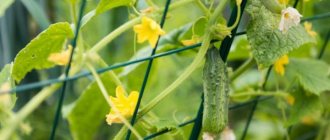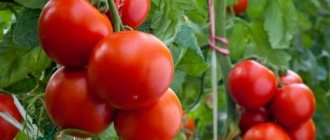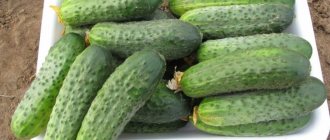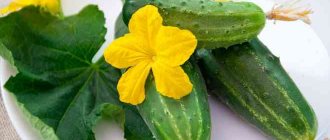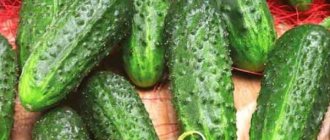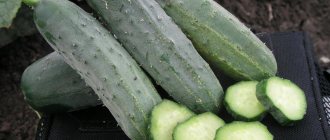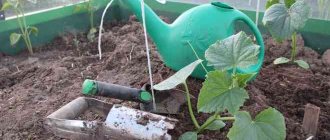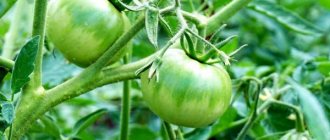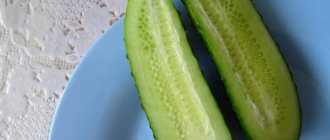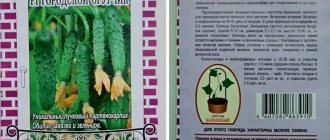History of variety development
This cucumber hybrid was created by Dutch breeders from the famous seed breeding company Nunhems at the end of the last century.
Almost immediately, vegetable growers from around the world, including Russia, drew attention to the new hybrid. The Ajax F1 cucumber passed variety testing and was included in the Russian State Register at the beginning of this century. What does F1 mean on a packet of seeds?
The Ajax F1 cucumber is recommended for growing in garden beds on private farms, as well as for cultivation on an industrial scale.
Related article:
The best varieties of pickling cucumbers
Cucumber Ajax F1 seeds Aelita
Advantages and disadvantages
Advantages of the Ajax hybrid:
- a bountiful harvest;
- resistance to cold and frost;
- excellent taste when canned, pickled and salted;
- marketable condition;
- tolerates transportation well;
- suitable for cultivation on an industrial scale;
- immunity to disease;
- Suitable for growing on pickles.
But in addition to its advantages, the hybrid has a number of disadvantages:
- requires pollination by bees;
- mediocre taste when fresh;
- not suitable for growing in greenhouses;
- thick skin.
Description of the variety
Ajax F1 is a Dutch hybrid variety that was one of the first to appear on the Russian seed market.
This cucumber is of the indeterminate type, so its central vine is not limited in growth. Genetically, the Ajax cucumber has active branching of lateral vines, so this hybrid needs to be grown on trellises or on a special cucumber net.
The bushes are very strong and large, with good foliage. The foliage is medium in size, wrinkled, rich emerald color.
Cucumber
variety Ajax F1 .
Mostly female flowers are formed on the vines, but since the plant requires pollination by bees, male flowers also appear on the bushes in sufficient quantities.
Flowers are formed in the leaf axils mainly in bunches, up to 3 pieces in each.
Related article:
Cucumber Dimka F1 - description and characteristics of an early variety
The variety is distinguished by early fruit ripening - about 1.5 months pass from the moment the seed material germinates to the harvesting of ripe gherkins. Since the bushes of this hybrid actively develop lateral shoots, on which ovaries begin to appear after the green shoots are completely collected from the central shoot, the Ajax F1 cucumber bears fruit almost until frost.
Ripe greens of this hybrid have a cylindrical shape with a smooth surface. The skin is quite dense, with a characteristic crunch, with medium-sized tubercles. Its color is dark emerald, with short light stripes and small spots. Cucumbers are covered with small light pubescence.
Cucumber variety Ajax F1 .
Greens are 10-11 cm in length, with an average diameter of about 3 cm and an average weight of about 90 g.
Related article:
Murashka F1 cucumber - description and characteristics of an early variety
The pulp of these cucumbers is juicy, tender, absolutely not bitter and has no voids. The taste of ripe greens is sweetish with a characteristic aroma. The cavity with seeds in ripe cucumbers is small.
The harvested crop can be transported over long distances and stored in appropriate conditions for a long time, which is very valuable when growing Ajax F1 cucumber on an industrial scale.
Cucumber care
Ajax cucumber varieties are demanding when it comes to watering; you need to carefully monitor the soil moisture and not allow it to dry out, otherwise the harvest will be poor. Loosening and weeding the soil is also an important element of caring for any plant. When there is a lot of weed grass in the beds, it absorbs all the microelements and moisture - the cucumbers do not receive anything. They stop growing, bearing fruit and eventually dry out.
The bush should be constantly formed; if neglected, growth will go into the green mass of the plant, not giving the desired harvest. To do this, the first three stepsons on the plant are broken off, then the stepsoning occurs according to the scheme 1 through 2 or 1 through 3.
Harvesting is carried out constantly; overgrown fruits will be hard and not tasty, and will retard the growth of new vegetables. Since the variety is early ripening, the collection of the first fruits will begin in mid-June and, depending on the weather conditions of the region, will continue until September.
With proper care, one bush produces 5 kilograms of fresh, tasty vegetables, which are subsequently used to prepare delicious fresh vegetable dishes, roll them into jars, pickle them, prepare pickled salads and much more.
https://www.youtube.com/watch?v=LsPLQXdBbdI
Although Ajax is not particularly picky about the choice of soil, it still needs to be fertilized before planting. For this you can use:
- rotted humus;
- mullein;
- chicken droppings;
- peat.
Landing Features
Fertilizer is applied at the rate of 5 kg. per 1 sq. m. It is applied in the fall before digging the soil, but in extreme cases this can be done in the spring.
Important! You need to plant seeds only when the threat of spring frosts has passed and the air temperature is at least 18°C.
Make small holes in the ground, moisten the soil with water and put 2-4 seeds in each hole. The seeds should be approximately 2 cm deep. After planting the seeds, the soil can be covered with agrofibre so that they germinate faster. The distance between the rows should be at least 50 cm, and it is advisable to maintain the same distance between the holes.
Cucumbers are watered with warm, settled water every 2 days; excessive waterlogging of the soil should be avoided.
Important! Stagnation of water in the soil can cause roots to rot.
Watering is carried out in the evening.
The beds must be regularly cleared of weeds. It is necessary to loosen the soil, but carefully: cucumbers have fragile roots that lie close to the surface.
Freeing the bed from weeds
It is recommended to plant the plant:
- the first stepsons are removed at 2-3 nodes of the main stem;
- the second time is removed at a height of 80 cm, after 2-3 leaves;
- the third time - at a height of 1 m, after 4 leaves.
Fertilizer is applied every 2-3 weeks.
- The first feeding is within 3 weeks after seed germination.
- The next feeding is during the flowering period.
- The third is during the fruiting period.
To do this, you can use organic fertilizers, for example, chicken manure (diluted in water in a ratio of 1:15), ash (1 liter of substance per bucket of water). Mineral fertilizers will also be used; per bucket of water you need: 10 grams. ammonium nitrate, 10 gr. superphosphate, 10 g. potassium salt. It is recommended to alternate feeding.
Since the plant has long stems, it must be tied to a trellis or grown on a net. If the bushes are not tied up, the cucumber stems may be injured during harvesting, and this reduces fruiting.
Note! Ajax cucumbers can be grown for pickles and gherkins.
The variety is characterized by high yield, bearing fruit right up to frost. The fruits are cylindrical, large-tubercular, dark green, 9-12 cm long. One cucumber weighs from 90-100 grams. From one sq. m. you can collect up to 4.5 kg of fruit. The collected fruits retain their green color for a long time.
Cucumbers are suitable for fresh consumption and for pickling. They can be grown both in private plots and on an industrial scale.
- Basic rules for caring for plants of the Ajax variety (F1):
- Frequent watering in the evening with warm, settled water;
- Regular loosening of the soil in the area with cucumbers;
- Weeding, removal of tops;
- Feeding bushes with organic matter and liquid mineral fertilizers.
It is necessary to water the plants in compliance with certain rules: the soil should not dry out and moisture should not stagnate. Excess water will lead to rotting of the root system of the bushes.
To increase productivity during the growing season, cucumbers need to be fed no more than 2 times a month. Organic fertilizers and nutritional mineral complexes are ideal as fertilizers.
Main characteristics of the variety
The Ajax F1 hybrid is highly resistant to sudden temperature changes and is not afraid of short-term cold snaps or extreme heat.
Productivity
Productivity of the Ajax F1 variety
The productivity of this hybrid is quite high - at least 5 kg of ripe products can be collected from each square of area.
Area of application of fruits
Ripe gherkins are tasty and crunchy, so they can be eaten fresh or added to various salads or snacks. Since no voids appear in these cucumbers during heat treatment, these fruits can be canned and salted. Moreover, the taste of pickled cucumbers only improves.
Related article:
Why cucumbers don't grow - gardener mistakes
Diseases and pests
Olive spot is not a problem for the Ajax F1 variety.
The Ajax F1 cucumber has high resistance to the main cucumber diseases:
- olive spot;
- cucumber spot virus;
- powdery mildew.
Of the harmful insects, the lashes of this cucumber can be damaged by aphids or spider mites. These pests can be combated with folk remedies: treat cucumber foliage on both sides with red pepper infusion and soap solution. If the colony of pests has grown too large, then you will have to use appropriate insecticidal preparations to spray the cucumber vines.
Important! Saving cucumbers from aphids
Growing rules
The plant needs to be fed
The description of the Ajax cucumber variety states that they are not particularly picky about the soil. But, to obtain high yields, the soil should be fed a little. The ideal time to fertilize the soil is autumn. During the cold weather, they will be able to absorb the maximum amount of nutrients. For fertilizer, organic substances are used, which are applied immediately after loosening the soil. Manure, wood ash or humus are used as organic matter.
Planting is carried out only at the moment when the winter frosts have stopped and the soil has warmed up quite well, because the seeds have good germination only in warm soil. Seeds should only be purchased that are already in a special glaze, because they have already been treated with special substances that will accelerate growth and disinfect.
The main advantages of the variety
The main positive qualities of the Ajax F1 hybrid cucumber include:
- early fruit ripening;
- good yield;
- resistance to major diseases affecting cucumber crops;
- the hybrid is resistant to temperature changes, which is very important - after all, this hybrid is grown only in garden beds;
- the harvested crop tolerates transportation well at any distance and is well stored in appropriate conditions;
- the collected fruits are of universal use; they can be collected at the gherkins and pickles stage.
Related article:
How to grow cucumbers in a house or apartment
Cucumber Ajax F1
Reviews from summer residents
Most gardeners give good characteristics of germination and yield. Typical reviews:
- A farmer from Volgograd notes that cucumber bears fruit until mid-autumn.
- Tatyana from Voronezh plants cucumbers 2 times per season. She also notes the variety's resistance to pests and diseases.
- Igor is pleased with the size and speed of fruit ripening. However, the Lipetsk gardener noted that the crop does not tolerate transplantation well. After planting the seedlings, the cucumber was sick for a long time.
Ajax F1 is a cucumber whose size has made it popular among lovers of vegetable pickles. It has good productivity and immunity. In order to draw the correct conclusion about the taste of a vegetable, you need to grow the crop yourself.
Nuances of planting and care
The Ajax F1 cucumber is not too demanding on planting conditions and further care, so even novice summer residents can grow this hybrid and get a good harvest from it.
The plant is grown only in garden beds, as it requires pollination by insects, and in greenhouse conditions and in film greenhouses it is difficult to arrange for bees to fly there.
Related article:
Cucumber Gunnar F1 - description and characteristics of an early ripening hybrid variety
Peculiarities of pinching, other rules of agricultural technology
Basics of growing the variety:
- cucumber can be planted directly in the ground or seedlings can be prepared;
- There should be no more than 3 bushes per 1 m²;
- soil acidity – average;
- for plants it is necessary to stretch trellises or mesh;
- formation is carried out using pinching and pinching.
Advice. It is necessary to monitor the rate of soil warming. Cucumber germinates well and is also accepted if the soil has warmed up to 18 degrees.
Principles of stepsoning:
- The 3 lower stepsons are completely removed.
- The shoots at a height of up to 1 m are pinched after the 3rd leaf.
- The upper stepsons are at the level of 4–5 leaves.
- The main stem is at a level convenient for the farmer.
Sowing seeds for seedlings | Planting seedlings in a greenhouse/greenhouse | Planting OG seedlings | Stepsoning | Harvesting |
| 2-3 days of April | — | Mid May | According to the scheme | End of June |
| *dates are indicated for central Russia | ||||
Landing
Planting Ajax F1 cucumber seeds
Planting Ajax F1 cucumber seeds is done directly in garden beds in warm Russian regions, or seedlings are first grown at home.
Although this plant is unpretentious to the composition and other parameters of the soil, fertilizers should be applied to the beds first so that the future harvest will be richer.
Preparing a place for planting cucumbers should begin in the fall, after harvesting from the beds. To do this, you need to remove all remnants of vegetation on the site along with the root system. Then organic matter is added to the beds at the rate of 6-7 kg for each square of area, which is embedded in the soil during autumn digging using one shovel.
Typically, the following organic matter is added in the autumn: rotted manure, high-moor peat, bird droppings.
Related article:
The most important thing about the problems of cucumbers
Depending on the weather conditions of the growing region, transplanting cucumber seedlings or sowing seeds is carried out in the following periods: from the last ten days of April to the first ten days of June.
The main condition for this is warming the soil to 16-17 degrees Celsius.
Immediately before planting, add superphosphate to the soil (1.5 tablespoons per square area) and 150 g of wood ash per 1 m2.
Seeds are sown in the soil in rows. In this case, the distance between neighboring plants should be about 0.2 m, and the row spacing should be 0.6 m. The seeds are buried in the soil by 1.5-2.0 cm, watered and wait for seedlings to emerge. There should be several seeds in each hole, and later the weaker plants are removed or transplanted to where nothing has sprouted.
To grow seedlings of this hybrid, the nutrient substrate can be purchased at the store or prepared independently by mixing humus, turf, peat and soil from the garden in equal quantities.
Seeds for seedlings are planted approximately 30-35 days before the intended transplantation to a permanent place in the garden. Seed material should be planted in separate containers so that the plants do not have to be picked. In the process of growing seedlings, they need to be watered regularly, and the water for watering should not be cold.
Related article:
Cucumber Athena F1 – variety characteristics, description and reviews
The air temperature in the room should be 19-20 degrees Celsius during the day, and about 17 degrees Celsius at night.
About a couple of weeks before transplanting, the cucumber bushes are watered with the following liquid fertilizer: 20 g of potassium sulfate and 30 g of superphosphate are dissolved in a bucket of water.
Preparing seedlings and seeds for direct sowing in the ground
To grow a healthy crop, you need to know the rules for pre-processing seed material, as well as familiarize yourself with the instructions for growing and caring for seedlings.
Seed preparation
As a rule, before sowing cucumber seeds in open ground or for seedlings, gardeners carry out the following activities: calibration, disinfection, hardening, germination. Manufacturers usually indicate on the packaging that the seeds have been pre-treated, in which case no additional measures are required. If you purchased Ajax F1 seeds and such information is not indicated on the packaging, then it is better to carry out the processing yourself to ensure the viability of the seeds and get healthy seedlings from them.
The color of cucumber seeds is white or cream. If you find colored seeds (green or orange) in the package, this indicates that they were processed in order to enrich them with useful substances.
Colored cucumber seeds do not need any processing
Calibration
- Sort out the seeds. Throw away the hollow and deformed ones, distribute the remaining ones according to size. There is an established opinion among gardeners that the strongest and healthiest shoots are produced by the largest seeds.
- Place the seeds in a container with salted water (5 g of salt per 100 ml of water) and stir. Seeds suitable for sowing will sink to the bottom, unsuitable ones will float to the surface.
- Remove healthy seeds from the saline solution, rinse thoroughly under running water and dry on a napkin or paper towel.
Using a saline solution you can determine the quality of seeds
Disinfection
This procedure is carried out in several ways, and you can choose the one that is most convenient for you.
Method 1
- Warm the seeds in the oven at 60°C for 3 hours.
- After this time, remove the seeds from the oven and place them in the potassium permanganate solution for 30 minutes.
- Remove the seeds from the solution and dry them on a napkin or paper towel.
Soaking seeds in a solution of potassium permanganate will effectively help disinfect them
Method 2
- Prepare an ash solution. To do this, mix 2 tbsp. l. ash with 1 liter of warm water and let the solution brew for 3 days.
- Immerse the seeds in the solution for 30 minutes.
- After this time, remove the seeds and dry them on a napkin or paper towel.
Using this method, you will not only disinfect the seed, but also enrich it with nutrients.
If you have the opportunity, you can treat the seeds with ultraviolet light - to do this, just hold them under a special lamp for 5 minutes.
Hardening
Keep in mind that after hardening, the seeds must be sown immediately in the ground. If you want to prepare seedlings, then in this case there is no need to harden the cucumber seeds.
- Wrap the seeds in a damp cloth.
- Place them in the refrigerator for two days. On the first day, place them next to the freezer, on the second - on the bottom shelf.
On the second day of hardening, the container with seeds should be placed on the lower shelves of the refrigerator.
Be careful not to let the fabric dry out. To do this, moisten it with a spray bottle as needed.
Germination
Make sure you have suitable water. Only soft water is suitable for soaking: melt, rain, boiled or settled. The water temperature should be approximately +20°C, but not exceed +25°C.
- Wet a piece of matting or cotton cloth with this water and wrap the seeds in it.
- Place the cloth with the seeds in a plastic bag. Place the package in a warm place for 3 days. The seeds should germinate during this period.
Cucumber seeds germinate in polyethylene in 3 days
You can replace the bag with a glass jar with a nylon lid - it will also serve as an excellent “greenhouse” for cucumber seeds, providing them with a sufficient level of humidity and the necessary amount of heat. But keep in mind that placing the jar on heating appliances is strictly prohibited.
It is advisable to germinate the seeds before sowing to know which ones are viable and which ones are not.
Preparing seedlings
As a rule, sowing cucumber seeds for seedlings begins three weeks before planting in open ground. Please note that Ajax F1, like other cucumbers, does not like transplanting, so it is best to sow the seeds in peat pots with a volume of 300–500 ml. If this is not possible, then use plastic containers of approximately the same volume - in large pots the soil is susceptible to acidification. Make drainage holes at the bottom of each container to avoid stagnation of water, and place the workpieces in a tray.
Prepare a suitable substrate for filling the pots. Ajax F1 is perfect for a mixture of garden or turf soil, humus and old sawdust (all components are taken in equal parts). If you are not growing seedlings in peat pots, then also add peat. To further enrich the soil with nutrients, mineral fertilizers are useful: urea, superphosphate or potassium sulfate. Mix the fertilizer with the substrate and fill each pot about halfway with the mixture.
It is necessary to prepare the soil with a reserve, since it can sag
Sow the seeds into the prepared substrate. This is done like this:
- Make a hole in the ground 2 cm deep and carefully place a dry or sprouted seed into it, trying to position it horizontally. The pointed end of the seed should point slightly upward.
- Carefully sprinkle the holes without compacting them.
- Moisten the substrate generously with warm, soft water using a spray bottle.
- Cover the plantings with film or glass and place in a warm place.
Usually shoots appear after 5 days. As soon as this happens, remove the film and provide your seedlings with sufficient sunlight by placing them on the windowsills of windows facing south. Keep in mind that the daylight hours for cucumber seedlings should last from 8 to 18 hours, otherwise they will not develop well.
You can fertilize after the seedlings have two true leaves.
Further care of seedlings consists of the following activities:
- Regular watering. The soil in the pots should not dry out, so it must be moistened daily or at least every other day, while avoiding stagnation of water. First use a spray bottle, and after the sprouts get stronger, you can water it with a watering can. For irrigation you need soft water at a temperature of at least 20°C.
- Loosening. A crust may form on the surface of the soil, making it difficult for the seedlings to breathe. To prevent this, carefully loosen the soil at least once every 2 weeks.
- Adding soil. As a rule, the soil in pots sags, so it is necessary to add it as needed, otherwise the Ajax F1 seedlings will stretch and weaken.
- Feeding. In total, seedlings require 2 feedings. The first is carried out when Ajax F1 has 2 true leaves. Prepare the following solution: 10 liters of water + 20 g of superphosphate fertilizers + 10 g of nitrate + 10 g of potassium sulfate. The second feeding is carried out immediately before planting the seedlings in the ground. For her, the solution is as follows: 10 liters of water + 20 g of potassium sulfate + 50 g of superphosphate fertilizers. Please note that first the substrate must be slightly moistened with plain water, then watered with a feeding solution, and then sprayed with clean water from a spray bottle.
- Hardening. Start a week before planting seedlings in the ground. For this purpose, take containers with seedlings out into the open air (for example, onto a balcony or veranda), but make sure that the sprouts are not exposed to direct sunlight.
